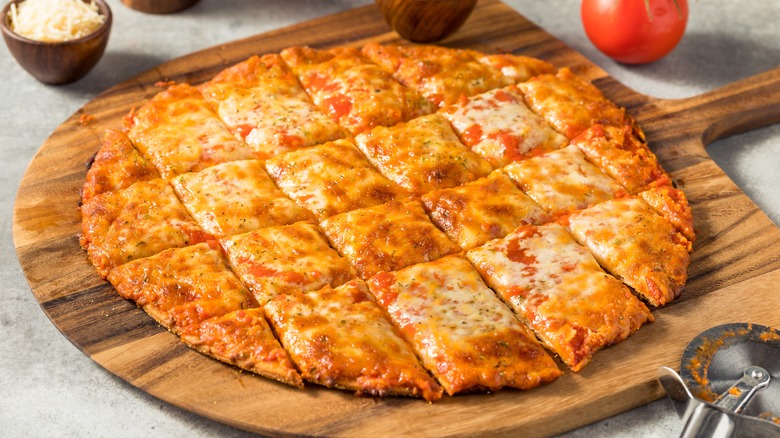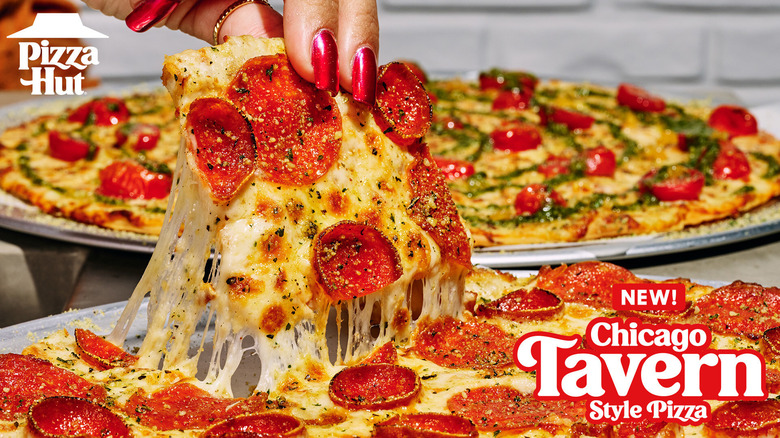What Sets Tavern-Style Pizza Apart From The Other Chicago Pies
When most people think of pizza in Chicago, the image of a thick deep dish comes to mind: A pie filled with massive amounts of cheese with sauce ladled on top. No matter what we do, we can't shake that reputation because, honestly, deep dish is such a fascinating and polarizing style of pizza.
The truth is, we natives don't eat deep dish regularly since it's not built for casual eating. Depending on the place, a slice of deep dish can become a fork and knife affair, and each pizza can take anywhere between 45 minutes to an hour to prepare, thanks to long baking times. And since a deep dish is so indulgent, we tend to view it as a treat rather than a staple.
Fortunately, Chicago and the Midwest have their own style of thin crust, which is more what we consider our utility, weeknight pizza. It goes by multiple names, such as tavern-style and party cut, but most of us simply refer to it as a thin crust or just "pizza." This style of crust can range slightly in thickness from an ever-so-slightly breadier dough with a chew to one that's cracker-thin and crisp. Because of the sturdiness of its crust, tavern-style pizza is a structural marvel that can hold an impressive amount of toppings. One of its signature qualities is how it's sliced because, unlike many styles of pizza, tavern-style pizza is cut into squares.
Why tavern-style pizza is cut into squares
Tavern-style pizza is named such because it was served at Chicago's drinking establishments, becoming particularly popular shortly after the end of Prohibition in the early 1940s. It's thought that the pizza was cut into squares to make it easy to handle on napkins since most taverns weren't equipped with cutlery or crockery.
Local pizza expert Steve Dolinsky told The Takeout in an interview some years back about the history of this practice. "The pizza was a freebie in the bar. As Marc Malnati [owner of pizza chain Lou Malnati's] told me, it was an afterthought. They'd pass the pizza around the bar, cut it into small squares, they want to get you to get something salty in your mouth so you keep ordering beers, keep drinking."
Sharing is caring, after all, and so that's why our local thin-crust pies are cut into squares. I grew up with this style, and the square cut means that it's really good for a crowd since you can eat a few slices as a snack at a gathering (try that with wedges), or if you're in a smaller group, you can eat as much as you want as a meal. See, even the way our pizza is sliced reflects our Midwestern hospitality.
Tavern-style pizza is having a national moment
Tavern-style pizza has gained national attention in recent years. Food writer J. Kenji López-Alt developed a recipe for The New York Times last year (full disclosure: I was one of his local tour guides when he was conducting research), and other national publications like Esquire showcased the style in recent media coverage.
Food trends come and go, but tavern-style pizza isn't a flash in the proverbial pizza pan. You know a style has legs when big chains take notice and start offering it on their menus. Pizza Hut recently released a square-cut thin crust version, which it named "Chicago Tavern Style Pizza." Giving tavern-style a place on its menu means Pizza Hut sees the potential for big bucks in this category, and the fact that it's using the name Chicago means the company acknowledges that thin crust, square-cut pizza has its identity intertwined with the Windy City. What's also important to note is that tavern-style pizza is now a permanent part of Pizza Hut's menu, which means it sees some serious promise in selling this style nationwide.
Sure, if you visit Chicago as a tourist, you have to try deep-dish pizza since you likely can't get that at home. But if you really want to eat like us, try the tavern-style. And one last tip: Make sure you order it with sausage. The springy and juicy fennel-flecked chunks of pork are our absolute favorite.


